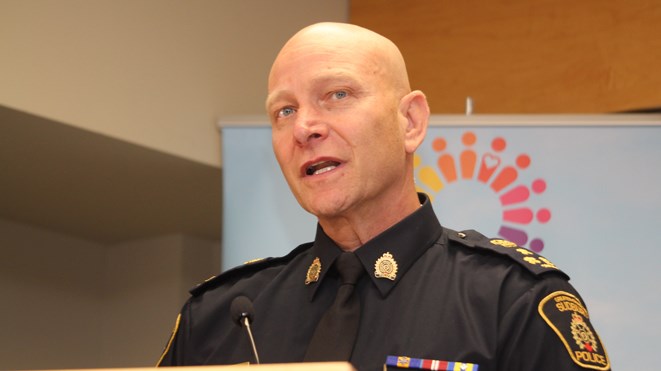Greater Sudbury Police Service continues to operate efficiently and effectively. That was the message from GSPS Chief Paul Pedersen as he presented the department's 2016 annual report during a police services board meeting on June 6.
The police service came in $17,372 under budget at the end of 2016, and are on course to be under budget in 2017 and are around $321,000 under their year to date budget from Jan. 1 - April 30.
While the GSPS hsa been able to meet its budget requirement, there were a few numbers that took a turn away from the trend and that drew some attention from the chief during his presentation. Crime numbers in terms of the number of offences took a jump for the first time in five years.
A number that had been on a steady decline since 2012, total offences jumped from 7,698 in 2015 to 8,067, an increase of 4.7 per cent. In addition to the increase in criminal offences, the GSPS saw a decrease in its clearance rate, dropping just below 50 per cent to 49.9 per cent, down from 53.4 per cent clearance in 2015.
"This is the first time in a number of years that we've seen an increase in crime and a decrease in clearance rate," said Pedersen.
"We're starting to see statistical support for what our frontline officers have been telling us, that our work is getting busier and it is becoming more difficult and increasingly complex to solve crime. It's impossible to determine whether this is an ongoing trend but it should cause us all to sit up and take note."
Pedersen explained that there isn't always a direct correlation between crime rates and and clearance rates, but rather the nature of the crimes that are seeing large increases, such as break and enters, are harder to solve.
Break and enters were up 19.6 per cent in 2016, while thefts of motor vehicles saw a decrease of 17.9 per cent. Property crimes on the whole were up slightly from 4,176 in 2015 to 4,288 in 2016 with the biggest increases coming from break and enters and fraud, which jumped up a shocking 47.1 per cent.
This number caught the eye of police services board member Gerry Montpellier.
"I'm looking at these fraud numbers and wondering what types of fraud does this include," said Montpellier.
Pedersen responded that this could be an instance of more frauds being reported, indicating that according to the Canadian Anti-Fraud Centre (CAFC) only five per cent of frauds are reported nationally.
"Something like someone's credit card being swiped for example, people will call their credit card company and take care of it that way, but they don't call the police to report it as a crime," said Pedersen.
When it comes to property crimes, namely break and enters, Pedersen encouraged Sudburians to be vigilant in protecting themselves against having someone break into their home.
"Make sure you have an outside light, keep your bushes trimmed down so someone can't hide behind it, keep trees trimmed so you have clear sight lines to your yard, make sure to lock your doors," said Pedersen. "I know we all want to trust that we live in a safe community, and these are all easy things to do to protect yourself."
With respect to the significant spike in frauds, when asked if Sudbury's aging population may have been a factor in the increase, Pedersen says that there was not one specific demographic that stood out as victims.
"It's not that seniors are more likely to fall victim to fraud, but they may be more likely to report crimes," he said.
While crime numbers did see an increase, the number of calls the police received didn't vary much and came in at around 60,000 which is right in line with a trend that has seen the number of calls decrease from year to year.
"We're trying to make the move from reactive to proactive policing," said Pedersen. "By far, the majority of the calls we receive are not criminal in nature, but they are still serious concerns. Things like distracted driving and others fall under the Highway Traffic Act not the criminal code, but we still treat those calls very seriously."*
The GSPS did see an eight per cent decrease impaired driving offences in 2016 with 149 total charges laid. A number that stood out for Pedersen was that their RIDE check stops caught significantly more impaired drivers in 2016 than they did in 2015.
Last year the GSPS RIDE program saw an increase of 53.3 per cent in identifying impaired drivers.
"This is a bit out of the norm, usually we don't see that many impaired drivers at RIDE stops, it's more the patrols that catch impaired drivers."
Overall, Pedersen says that he is proud of the work being done by the GSPS in the community and that they continue to operate under budget.
"I think this shows that we are operating efficiently and effectively," said Pedersen. "I just want say a job well-done to everyone."
*An earlier version of this story incorrectly stated impaired driving offences were not criminal. Impaired driving is criminal. That error has been corrected.



